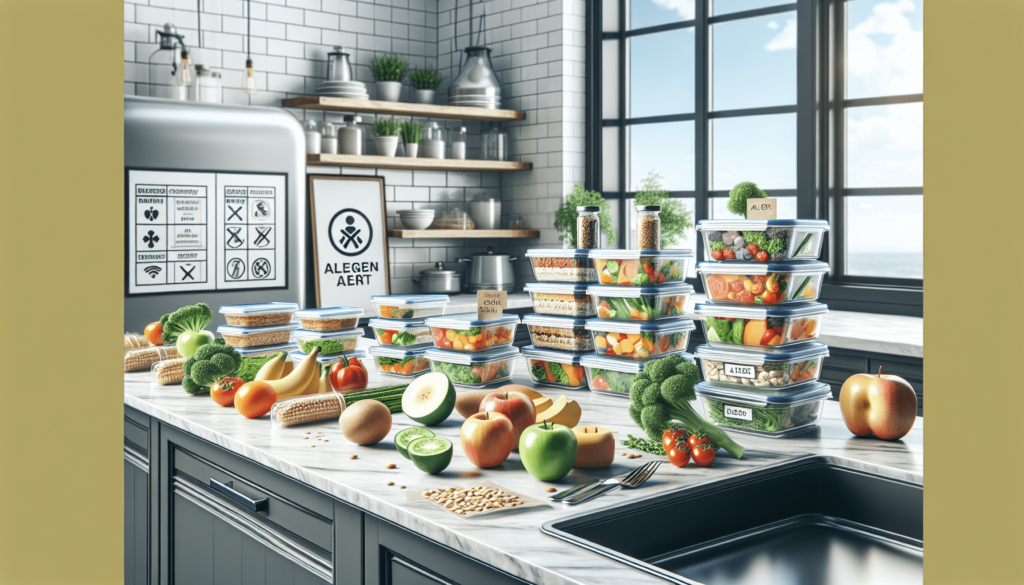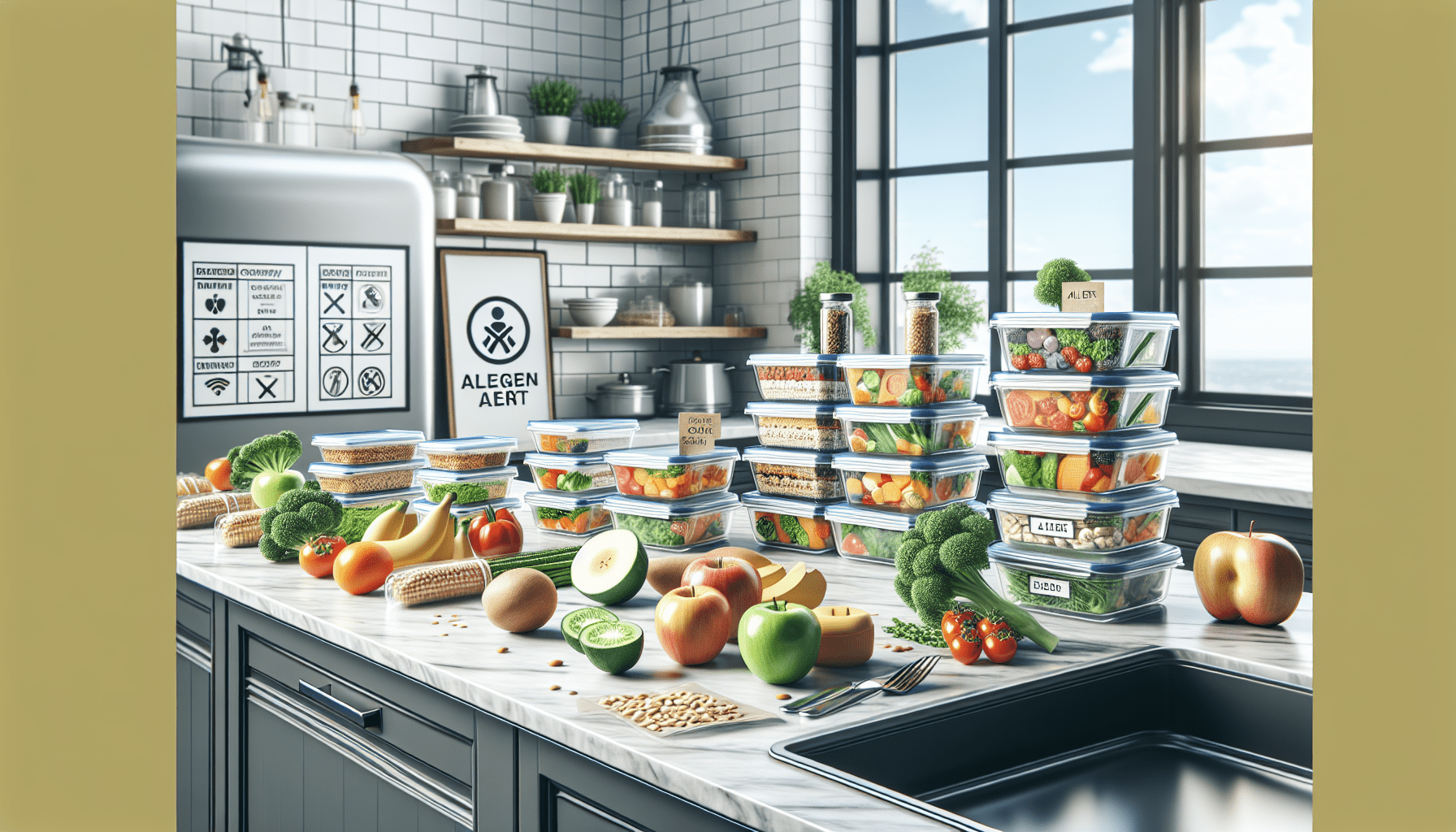Have you ever found yourself feeling overwhelmed trying to manage meal prepping with food allergies? You’re definitely not alone. Navigating the world of meal prep is already a challenge, but adding the complexity of food allergies can seem downright daunting. With some knowledge and a bit of planning, you can easily create delicious, safe, and nutrition-packed meals that cater to your specific dietary needs.
Understanding Food Allergies
Food allergies are more common than you might think. They can affect anyone and range from mild to severe reactions. Before diving into meal prepping, it’s essential to grasp the basics of food allergies and why they matter so much in meal planning.
What Are Food Allergies?
Food allergies occur when your immune system mistakenly identifies a particular food as harmful. This triggers a range of allergic reactions that can be mild, such as itching or hives, to severe, like anaphylaxis. Common food allergens include peanuts, tree nuts, milk, eggs, fish, shellfish, wheat, and soy.
Symptoms of Food Allergies
Recognizing the symptoms of food allergies can help you manage and avoid allergens effectively. Symptoms can include:
- Hives or skin rashes
- Swelling of lips, face, tongue, or throat
- Difficulty breathing
- Stomach pain, nausea, or vomiting
- Dizziness or fainting
Understanding these symptoms can help you act quickly if an allergic reaction occurs and tailor your meal planning to avoid triggering them.
Why Meal Prepping Matters
Meal prepping isn’t just a trendy buzzword; it’s a useful strategy that can save you time, money, and stress. When you’re dealing with food allergies, meal prepping takes on an added level of importance. Let’s explore why.
Benefits of Meal Prepping
By planning and preparing your meals in advance, you can:
- Ensure food safety: Avoid cross-contamination and manage ingredients carefully.
- Save time: Cook once and eat multiple times.
- Control portion sizes: Helps with maintaining a balanced diet.
- Stay organized: Reduce the chaos of last-minute cooking.
Common Meal Prep Mistakes
Even seasoned meal preppers can make mistakes. The most frequent errors include not having a clear plan, prepping too much food that goes to waste, and failing to vary your menu, which can lead to food fatigue. Keep these pitfalls in mind as you move forward.

Steps to Successful Meal Prepping
The secret to successful meal prepping lies in the planning. Taking it step-by-step ensures you cover all your bases and sets you up for success.
Identify Your Allergens
The first step is identifying your specific food allergens. Once you know what to avoid, you can build your meal plan around safe substitutes and alternatives.
Common Food Allergens and Alternatives
| Food Allergen | Common Substitutes |
|---|---|
| Milk | Soy milk, almond milk, oat milk |
| Eggs | Applesauce, mashed bananas, flaxseeds |
| Wheat | Gluten-free flours (rice, almond) |
| Peanuts | Sunflower seed butter, pumpkin seeds |
| Shellfish | Tofu, chicken, mushrooms |
Plan Your Meals
to Plan which meals you’ll prep, taking into account your allergies, nutritional needs, and food preferences. You can create a menu for the entire week, including breakfast, lunch, dinner, and snacks.
Tip: Try to incorporate balance and variety. For instance, if you’re avoiding wheat, explore gluten-free grains like quinoa or brown rice.
Create a Shopping List
Make a detailed shopping list based on your planned meals. This ensures you have all the safe ingredients you need and helps avoid impulse purchases. Having a specialized list also helps in navigating through the aisles more efficiently.
Tip: Always check labels for hidden allergens. Many processed foods contain ingredients derived from common allergens.
Preparation and Cooking
Once you have your ingredients, it’s time to prepare and cook. This is where you put your plan into action. Organize your kitchen, clean your utensils, and start cooking in batches.
Tip: Multi-tasking makes meal prepping efficient. Cook several dishes simultaneously, such as baking a casserole while stir-frying vegetables.
Storage and Safety
Proper storage is crucial to keep your prepped meals fresh and safe from contamination.
Storing Your Prepped Meals
Use airtight containers to store your meals in the refrigerator or freezer. Label each container with the date and meal description to keep track easily.
Best Practices for Storage
| Storage Method | Best Practices |
|---|---|
| Refrigerator | Store meals for 3-4 days, keep at or below 40°F (4°C) |
| Freezer | Store meals for up to 3 months, keep at or below 0°F (-18°C) |
| Airtight Containers | Use BPA-free containers to prevent spills and contamination |
| Labeling | Label each meal with the date and specific allergens it avoids |
Preventing Cross-Contamination
Cross-contamination is one of the biggest risks in meal prepping for food allergies. To prevent it:
- Use separate cutting boards and utensils for allergenic and non-allergenic foods.
- Always clean prep surfaces thoroughly.
- Store allergen-free meals separately from other foods.

Practical Meal Prep Ideas
Now that you’ve got the planning and theoretical aspects down, it’s time to get practical. Here are some meal ideas that cater to common food allergies.
Breakfast
Breakfast can be a tricky meal if you have food allergies, but there are plenty of options.
Recipes
- Overnight Oats: Use gluten-free oats, almond milk, and a variety of fruits.
- Smoothie Bowls: Blend frozen fruits with a dairy-free milk base and top with seeds and nuts.
- Egg Muffins (without eggs): Use mashed sweet potatoes, veggies, and flaxseeds.
Lunch
For lunch, aim for meals that are easy to pack and reheat.
Recipes
- Quinoa Salad: Mix cooked quinoa with chickpeas, chopped veggies, and a lemon-tahini dressing.
- Lettuce Wraps: Fill large lettuce leaves with a mix of ground turkey, bell peppers, and a soy-free sauce.
- Rice Bowls: Make a base with brown rice, add steamed broccoli, grilled chicken, and a dairy-free sauce.
Dinner
Dinner is usually the most complex meal, but it doesn’t have to be overwhelming.
Recipes
- Stir-Fry: Use a variety of colorful vegetables, tofu, and a sauce made from coconut aminos.
- Gluten-Free Pasta: Toss with a homemade tomato sauce and vegetables.
- Baked Salmon: Season with herbs, bake in foil, and serve with sweet potatoes and asparagus.
Snacks
Snacks can keep you energized throughout the day without compromising your dietary needs.
Snack Ideas
- Fruit Kabobs: Skewer various fruits like grapes, pineapple, and strawberries.
- Nut-Free Trail Mix: Mix seeds, dried fruits, and allergen-free chocolate chips.
- Veggie Chips: Bake thin slices of beets, sweet potatoes, and zucchini.
Maintaining Balance and Variety
One of the challenges of meal prepping for food allergies is maintaining both balance and variety to keep your meals enjoyable and nutritious.
Nutritional Balance
Ensure your meals are balanced by including:
- Proteins: Lean meats, tofu, legumes.
- Carbohydrates: Gluten-free grains, potatoes.
- Fats: Avocado, olive oil, dairy-free spreads.
- Vitamins and Minerals: Fresh fruits and vegetables.
Varying Your Menu
Rotate your dishes weekly and explore different cuisines to keep things interesting. Try adding a new vegetable or gluten-free grain you haven’t tasted before. Explore different cooking techniques like grilling, steaming, or baking.
Trouble-Shooting Common Issues
It’s inevitable to face some hiccups while meal prepping, especially if you’re new to it. Here are some solutions to common problems.
Time Management
Finding the time to prep meals can be challenging. Set aside a specific day of the week as your meal prep day. It might be Sunday for some, while others prefer a weekday evening.
Ingredient Availability
Sometimes, you might not find the allergen-free ingredients you need. Keep a list of substitutes handy and be flexible with your recipes.
Flavor Fatigue
Eating the same meal day in and day out can lead to flavor fatigue. Spice things up by using different herbs and seasonings. Sometimes, a sprinkle of fresh herbs can drastically change the taste of a dish.
Advanced Tips for Seasoned Meal Preppers
If you’ve got the basics down and are looking to take your meal prepping to the next level, consider these advanced tips.
Batch Cooking and Freezing
Batch cooking allows you to make large quantities of meals and store them in the freezer. This is especially useful for busy weeks.
Tip: Freeze meals in individual portions for easier defrosting and reheating.
Streamlining Your Prep
Use kitchen gadgets like slow cookers, instant pots, and food processors to cut down on prep time.
Tip: Pre-chop vegetables and store them in the fridge or freezer for quick use.
Keeping a Recipe Journal
Maintain a journal of successful recipes and tweaks. Note what worked and what didn’t, so you can continually improve your meal prep process.
Conclusion
Managing food allergies while meal prepping doesn’t have to be a daunting task. By understanding your allergens, planning carefully, and employing smart cooking and storage techniques, you can enjoy a variety of delicious, safe, and nutritious meals. Remember, the goal is to make meal prepping a seamless part of your routine while ensuring every bite is safe and satisfying.
You’ve got the know-how now — it’s only a matter of time and practice before you become a meal prepping pro!
